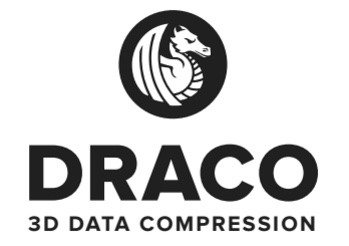Repository Summary
| Checkout URI | https://github.com/google/draco.git |
| VCS Type | git |
| VCS Version | 1.3.6 |
| Last Updated | 2020-03-03 |
| Dev Status | MAINTAINED |
| Released | RELEASED |
| Tags | No category tags. |
| Contributing |
Help Wanted (-)
Good First Issues (-) Pull Requests to Review (-) |
Packages
README

News
Version 1.3.6 release
- WASM and JavaScript decoders are now hosted from a static URL
- It is recommended to always pull your Draco WASM and JavaScript decoders from this URL:
- https://www.gstatic.com/draco/v1/decoders/
- Users will benefit from having the Draco decoder in cache as more sites start using the static URL
- Changed web examples to pull Draco decoders from static URL
- Added new API to Draco WASM decoder, which increased performance by ~15%
- Decreased Draco WASM decoder size by ~20%
- Added support for generic and multiple attributes to Draco Unity plug-ins
- Added new API to Draco Unity, which increased decoder performance by ~15%
- Changed quantization defaults:
- POSITION: 11
- NORMAL: 7
- TEX_COORD: 10
- COLOR: 8
- GENERIC: 8
- Code cleanup
- Bug fixes
Version 1.3.5 release
- Added option to build Draco for Universal Scene Description
- Code cleanup
- Bug fixes
Version 1.3.4 release
- Released Draco Animation code
- Fixes for Unity
- Various file location and name changes
Version 1.3.3 release
- Added ExpertEncoder to the Javascript API
- Allows developers to set quantization options per attribute id
- Bug fixes
Version 1.3.2 release
- Bug fixes
Version 1.3.1 release
- Fix issue with multiple attributes when skipping an attribute transform
Version 1.3.0 release
- Improved kD-tree based point cloud encoding
- Now applicable to point clouds with any number of attributes
- Support for all integer attribute types and quantized floating point types
- Improved mesh compression up to 10% (on average ~2%)
- For meshes, the 1.3.0 bitstream is fully compatible with 1.2.x decoders
- Improved Javascript API
- Added support for all signed and unsigned integer types
- Added support for point clouds to our Javascript encoder API
- Added support for integer properties to the PLY decoder
- Bug fixes
Previous releases
https://github.com/google/draco/releases
Description
Draco is a library for compressing and decompressing 3D geometric [meshes] and [point clouds]. It is intended to improve the storage and transmission of 3D graphics.
Draco was designed and built for compression efficiency and speed. The code supports compressing points, connectivity information, texture coordinates, color information, normals, and any other generic attributes associated with geometry. With Draco, applications using 3D graphics can be significantly smaller without compromising visual fidelity. For users, this means apps can now be downloaded faster, 3D graphics in the browser can load quicker, and VR and AR scenes can now be transmitted with a fraction of the bandwidth and rendered quickly.
Draco is released as C++ source code that can be used to compress 3D graphics as well as C++ and Javascript decoders for the encoded data.
Contents
File truncated at 100 lines see the full file
CONTRIBUTING
Want to contribute? Great! First, read this page (including the small print at the end).
Before you contribute
Before we can use your code, you must sign the Google Individual Contributor License Agreement (CLA), which you can do online. The CLA is necessary mainly because you own the copyright to your changes, even after your contribution becomes part of our codebase, so we need your permission to use and distribute your code. We also need to be sure of various other things—for instance that you’ll tell us if you know that your code infringes on other people’s patents. You don’t have to sign the CLA until after you’ve submitted your code for review and a member has approved it, but you must do it before we can put your code into our codebase. Before you start working on a larger contribution, you should get in touch with us first through the issue tracker with your idea so that we can help out and possibly guide you. Coordinating up front makes it much easier to avoid frustration later on.
Code reviews
All submissions, including submissions by project members, require review. We use GitHub pull requests for this purpose. Please make sure that your code conforms with our coding style guidelines.
The small print
Contributions made by corporations are covered by a different agreement than the one above, the Software Grant and Corporate Contributor License Agreement.
